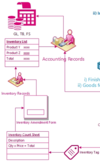Inventory and Production Cycle Flashcards
(44 cards)
When is Process Costing used?
A large quantity of like items are manufactured in a production line
What is a Job Card
Document that tracks the stages of production for a specific job. As costs accumulate they are recorded and O/H allocation is made to arrive at total cost
What should the written instructions regarding the count cover?
- The identification of count teams and responsibilities of each
- The method of counting (Tags, double count, marking counted inventory in two colours with chalk)
- Identification of slow moving/damaged inventory as well as consignment inventory
- Controls over issues to and returns of inventory sheets to the count controller
- Procedures to be adopted if problems arise during the count o Detailed instructions concerning dates, time, locations
What other method is allowed per IAS 2 (pertaining specifically to manufactured goods)?
Standard Costing method - where the standard cost approximates actual cost only. Hence we must flex the standard cost for variances that are controllable.
What are the three things the internal controls in inventory cycle should prevent
Control over physical transfer Protect inventory from damage, loss or theft Provide information required to calculate a cost for manufactured goods
What two functions does the production stage of the Inventory and Production Cycle perform?
1) Purpose is to manufacture the company’s products
2) Required to:
i) Requisition & Receive components
ii) Control costs during manufacture
iii) Record Actual Costs
iv) Account for items produced and to transfer them to the warehouse facility
v) Compare actual and budgeted costs
A document used to notify manufacturing/production department as to what is to be produced, based on sales forecasts, current inventory holdings of F.G. and specific orders/contracts, is known as what?
Manufacturing/Production Schedules
What sequenced document used to record adjustments which must be made to correct the perpetual inventory records when actual and theoretical inventory do not agree,
Inventory Amendment Form
Give 3 risks that can arise in the warehousing stages of the Inventory and Production Cycle?
(Give any of the following:) 1) Goods received from suppliers are not transferred into warehouses timeously or at all (stolen); 2) Inventory (in any form) is stolen or lost; 3) Inventory Deteriorates in value e.g. Inadequate physical controls (gets wet) or due to its nature; 4) No record is created for goods or components physically moved; 5)Goods produced or moved are incorrect resulting in lost sales or production delays; or 6) Inventory shortages are concealed (including those due to theft)
Give an example of how management could overstate its inventory
(any one) 1) By manipulating/changing the cost formula used (e.g. changing from WA to FIFO where prices are increasing) 2) capitalising costs that should not be, in terms of IAS 2 (e.g. capitalising administrative overheads)
How should the count teams be made up?
One member of the inventory process the other completely independent
How many times should be inventory be counted during a count?
Twice
Should inventory still be dispatched during the count?
No
What internal control would you expect to satisfy the Existence and/or Completeness Assertion?
Inventory Stock Counts
Explain what the Existence Assertion means in relation to Inventory.
All inventory actually exists at the financial statement date and that it is not overstated or fictitious
Give examples of controls that can be implemented specifically to prevent damage, theft or loss.
- Physical Controls
- Reconciliation and comparisons of information
- Regularly supervisory checks to identify unauthorised resource use
- Segregation of Duties - The same person should not have responsibility for custody of stock and maintaining records.
Explain what the Valuation and Allocation Assertion means in relation to Inventory.
Inventory is included in the financial statements at an appropriate amount (This includes write- downs to NRV), utilising an appropriate costing formulas. (Namely the quantity of goods and price per unit)
What should counters do once they are finished with their count?
The counters responsible for count sheets should:
- Draw lines through all blank spaces on all inventory sheets, and
- Sign each count sheet and all alterations.
What is the main risk associated with Inventory balance? Over-/understatement, and why?
Overstatement. Management would attempt to increase profits by increasing the closing balance of inventory and at the same time showing a higher asset value
What should happen to inventory received during the count?
It should be received in a separate area and counted. This amount should be added to the count of the warehouse.
What are the four costing formulae used?
- FIFO - Most common Method
- Weighted Average - Used in manufacturing processes where its difficult to distinguish items
- Specific Identification - for unique goods (job costing)
- Retail Method - used by small business, set SP, using Markup they work out the cost.
Give 3 Risks that may arise during the production stage of the Inventory and Production Cycle.
(Give any 3 of the following:)
- Unauthorised requisitioning or issuing of materials (theft);
- Requisition or issue of incorrect materials resulting in losses from wastage/delays;
- Failure to budget costs properly resulting in selling prices which are too low and subsequent losses;
- Failure to monitor actual expenditures and identify variances between actual and budget; and
- Failure to control the transfer of finished goods to the finished goods store (stolen, lost or damaged)
The Inventory and Production Cycle deals with two main aspects of Inventory, what are they?
i. The custody & safekeeping of inventory in whatever form it is – goods held for resale or manufactured and finished goods (WIP & FG); and ii. The recording of costs where a production or manufacture process occurs (Process or Job Costing)
What Assertions apply to the Inventory Balance in the SFP?
Existence, Rights and Obligations, Completeness, Valuation and Allocation






